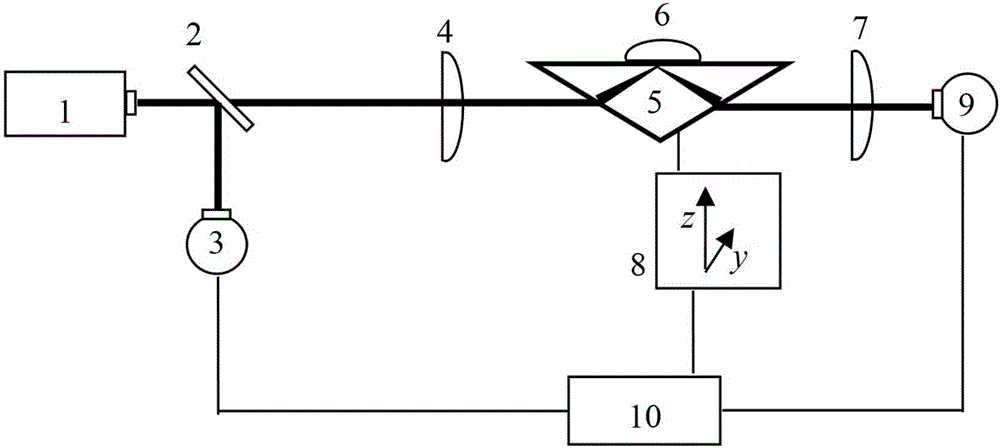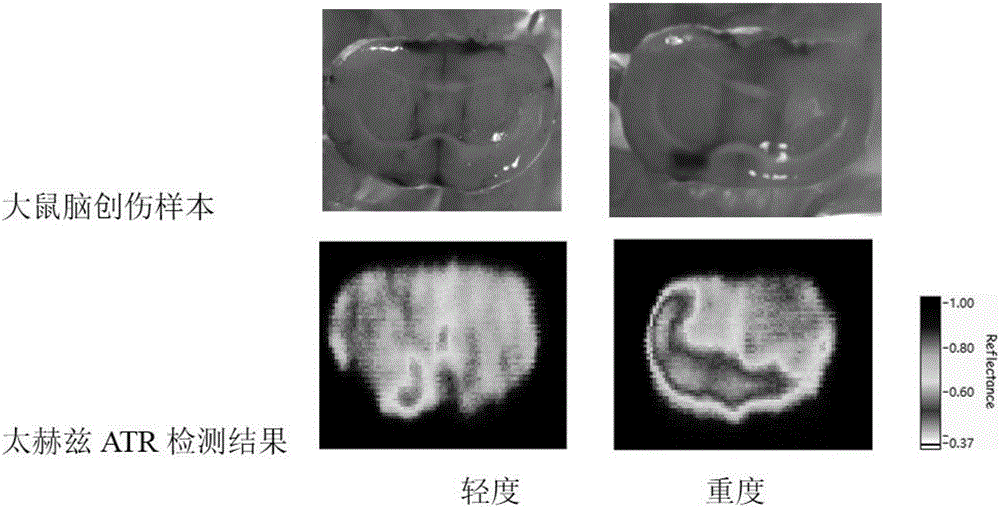Terahertz wave attenuation total reflection imaging-based cerebral trauma tissue detection device
A technology of attenuated total reflection and terahertz waves, applied in diagnostic recording/measurement, medical science, sensors, etc., can solve problems such as weak anti-interference ability, difficulty in ensuring accuracy, surviving brain tissue, wounded, dead and disabled, etc., to achieve safety The effect of high accuracy, no interference fringes, and avoidance of destructive analysis
- Summary
- Abstract
- Description
- Claims
- Application Information
AI Technical Summary
Problems solved by technology
Method used
Image
Examples
Embodiment 1
[0037] A brain trauma tissue detection device based on terahertz wave ATR imaging, see figure 1 , the detection device includes: a terahertz source 1, a terahertz beam splitter 2, a first terahertz aspheric lens 4 and a second terahertz aspheric lens 7, a total reflection prism 5, a biological sample to be measured 6, a two-dimensional moving scanning Platform 8 , first terahertz wave detector 3 , second terahertz wave detector 9 and computer control system 10 .
[0038] The terahertz source 1 emits terahertz waves with a frequency range of 0.1THz-30THz. The terahertz waves emitted by the terahertz source are incident on the terahertz beamsplitter 2, and the terahertz beamsplitter 2 is adjusted to form a certain angle with the incident terahertz waves. (10—80°), so that the incident terahertz wave is divided into a transmission terahertz wave and a reflected terahertz wave with a certain light intensity, and the terahertz wave reflected by the terahertz beam splitter 2 is used...
Embodiment 2
[0052] Combine below figure 2 , the feasibility verification of the device in Example 1 is carried out, see the following description for details:
[0053] In the embodiment of the present invention, the detection of brain trauma in mice is taken as an example, and a terahertz source with a frequency of 2.52 THz is used. First, two fresh rat brain tissue samples with different degrees of trauma were prepared by medical means. In order to make the biological sample 6 to be tested closely contact with the upper surface of the total reflection prism 5, the surface to be tested was repaired and flattened with a cryostat, and then the brain tissue Placed on the total reflection prism 5, use the computer control system 10 to control the movement of the total reflection prism 5 to realize point-by-point scanning, and collect each point of the rat brain tissue through the first terahertz detector 3 and the second terahertz detector 9 respectively Corresponding to the two light inten...
PUM
 Login to View More
Login to View More Abstract
Description
Claims
Application Information
 Login to View More
Login to View More - R&D Engineer
- R&D Manager
- IP Professional
- Industry Leading Data Capabilities
- Powerful AI technology
- Patent DNA Extraction
Browse by: Latest US Patents, China's latest patents, Technical Efficacy Thesaurus, Application Domain, Technology Topic, Popular Technical Reports.
© 2024 PatSnap. All rights reserved.Legal|Privacy policy|Modern Slavery Act Transparency Statement|Sitemap|About US| Contact US: help@patsnap.com









